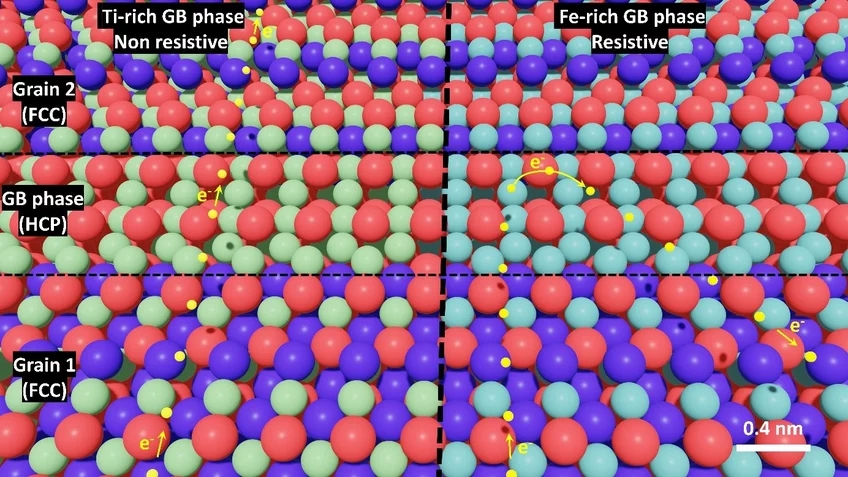博文
更多的能源来自余热
 精选
精选
||
更多的能源来自余热
诸平
据德国马普学会(Max Plank Society)2023年4月28日提供的消息,更多的能源来自余热(More power from waste heat)。
燃烧化石燃料和生物燃料时,大量能量会以废热的形式损失掉。热电材料(Thermoelectric materials)可以将这种热量转化为电能,但它们在技术应用方面的效率还不够高。一个由德国和美国研究人员组成的研究团队,现在通过阐明微观结构对材料的影响,并通过添加钛优化材料的性能来提高热电材料的效率。
气候危机迫使我们不仅要逐步淘汰化石燃料,还要节约能源。尤其是在化石燃料还不能很快被替代的地方,至少应该有效地使用它们——例如,利用能源密集型工厂或发电站的废热发电。目前,欧洲工业使用的能源中约有17%作为废热损失掉了。它可以在热电材料的帮助下加以利用。在这种热电装置中,当它们暴露于温差时会产生电压。然而,目前的热电器件效率不足以用于大规模工业。由总部位于德国杜塞尔多夫的马克斯-普朗克铁研究所(Max-Planck-Institut für Eisenforschung GmbH简称MPIE / Max Planck Institute for Iron Research, Düsseldorf, Germany)领导的研究团队现已成功优化热电,因为这些材料在技术术语(technical jargon)中是已知的,因此更接近于工业用途。相关研究结果于2023年2月15日已经在《先进能源材料》(Advanced Energy Materials)杂志网站发表——Ruben Bueno Villoro, Duncan Zavanelli, Chanwon Jung, Dominique Alexander Mattlat, Raana Hatami Naderloo, Nicolás Pérez, Kornelius Nielsch, Gerald Jeffrey Snyder, Christina Scheu, Ran He, Siyuan Zhang. Grain boundary phases in NbFeSb half-Heusler alloys: A new avenue to tune transport properties of thermoelectric materials. Advanced Energy Materials, 2023, 13(13): 20224321. DOI: 10.1002/aenm.202204321. First published: 15 February 2023. https://onlinelibrary.wiley.com/doi/10.1002/aenm.202204321
参与此项研究的有来自德国 杜塞尔多夫的马克斯-普朗克铁研究所(Max-Planck-Institut für Eisenforschung GmbH简称MPIE / Max Planck Institute for Iron Research, Düsseldorf, Germany)、德国德累斯顿的莱布尼茨固态和材料研究所(German: Leibniz-Institut für Festkörper- und Werkstoffforschung Dresden简称IFW Dresden, Dresden, Germany / The Leibniz Institute for Solid State and Materials Research in Dresden, Dresden, Germany) 以及美国西北大学(Northwestern University, Evanston, IL, USA)的研究人员。
该团队研究了一种铌(niobium, Nb)、铁(Fe)和锑(antimony, Sb)的合金,它可以在大约 70~700 ℃的温度范围内将废热转化为电能,效率为8%——这使得该合金成为目前最高效的热电材料之一。只有由铋(bismuth, Bi)和碲(tellurium, Te)制成的材料才能达到类似的值。然而,碲化铋(bismuth telluride)只适合在相对较低的温度下使用,并且机械稳定性不如由铌、铁和锑制成的热电材料。此外,其成分不易获得。
钛提高导电性(Titanium improves electrical conductivity)
为了进一步提高由铌、铁和锑制成的热电的效率,研究人员着重研究了它的微观结构。与大多数金属一样,热电材料由微小的晶体组成。晶粒的组成和结构,以及晶粒之间空间被称为晶界(grain boundaries)的特性,对热电材料的导热性和导电性至关重要。先前的研究表明,晶界会降低材料的导热性和导电性。为了获得尽可能高的效率,热导率应尽可能低,以便热量(即能量)保留在材料中。然而,电导率应该很高,以便将尽可能多的热量转化为电能。因此,来自马克斯普朗克铁研究所、美国西北大学和德累斯顿莱布尼茨固体和材料研究所的研究小组的目标是优化晶界,使其只降低导热性,而不降低导电性。
马克斯普朗克铁研究所的博士生鲁本·布埃诺·比略罗(Ruben Bueno Villoro)说:“我们使用扫描透射电子显微镜(scanning transmission electron microscopes)和原子探针(atom probes)来研究合金的微观结构,直至原子水平。我们的分析表明,需要优化晶界以改善电气性能和热性能。” 材料中的晶粒越小,晶界数量越多,导电性越差,”同一研究小组的项目负责人张思远(Siyuan Zhang音译)解释说。“增加材料中晶粒尺寸没有意义,因为较大的晶粒会增加导热性,我们会损失热量,从而损失能量。因此,我们必须找到一种方法来提高导电性,尽管颗粒很小。” 研究人员通过用钛富集材料解决了这个问题,除其他外,钛会积聚在晶界并增加导电性。通过这种方式,他们将合金的热电效率提高了40%。然而,对于实际应用,效率仍然需要显著提高。
下一步:在晶界选择性富集钛(Next step: selective enrichment of titanium at grain boundaries)
现在,研究团队正在分析如何选择性地将钛添加到晶界,而不用钛富集整个材料。这种策略节省了成本,并在很大程度上保留了热电材料的原始化学成分。目前的研究表明,功能特性如何与材料的原子结构相关联,以专门优化某些特性。
本研究得到了国际马克斯普朗克能量转换界面控制材料研究学院(International Max Planck Research School for Interface Controlled Materials for Energy Conversion 简称IMPRS-SurMat)、德国研究基金会(DFG)合作研究中心{ German research foundation (DFG) within the Collaborative Research Centre SFB 1394 “Structural and Chemical Atomic Complexity– From Defect Phase Diagrams to Materials Properties” (Project ID 409476157)}、德国研究基金会{DFG , Project Number 453261231;DFG under the framework of SPP 2370 (Project number: 502202153).};美国国家航空航天局(NASA)空间技术研究生研究机会{ National Aeronautics and Space Administration (NASA) Space Technology Graduate Research Opportunity }、美国能源部,能源效率和可再生能源办公室(EERE)计划加速发现用于直接热能转换的复合合金{ U.S. Department of Energy, Office of Energy Efficiency and Renewable Energy (EERE) program “Accelerated Discovery of Compositionally Complex Alloys for Direct Thermal Energy Conversion” (DOE Award DE-AC02-76SF00515)}、美国商务部,国家标准与技术研究院{ Award 70NANB19H005 from the U.S. Department of Commerce, National Institute of Standards and Technology, as part of the Center for Hierarchical Materials Design (CHiMaD)}以及韩国国家科学基金基础科学研究计划项目{ Basic Science Research Program of the National Research Foundation of Korea (NRF) (grant number 2021R1A6A3A03045488)}的资助或支持。
上述介绍,仅供参考。欲了解更多信息,敬请注意浏览原文或者相关报道。
Many thermoelectric materials benefit from complex microstructures. Grain boundaries (GBs) in nanocrystalline thermoelectrics cause desirable reduction in the thermal conductivity by scattering phonons, but often lead to unwanted loss in the electrical conductivity by scattering charge carriers. Therefore, modifying GBs to suppress their electrical resistivity plays a pivotal role in the enhancement of thermoelectric performance, zT. In this work, different characteristics of GB phases in Ti-doped NbFeSb half-Heusler compounds are revealed using a combination of scanning transmission electron microscopy and atom probe tomography. The GB phases adopt a hexagonal close-packed lattice, which is structurally distinct from the half-Heusler grains. Enrichment of Fe is found at GBs in Nb0.95Ti0.05FeSb, but accumulation of Ti dopants at GBs in Nb0.80Ti0.20FeSb, correlating to the bad and good electrical conductivity of the respective GBs. Such resistive to conductive GB phase transition opens up new design space to decouple the intertwined electronic and phononic transport in thermoelectric materials.
https://m.sciencenet.cn/blog-212210-1386304.html
上一篇:化学家们解决了回收混合塑料的艰巨挑战
下一篇:替代电池技术的进展
